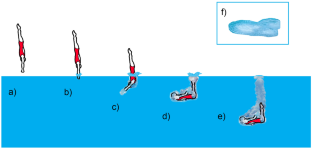Air cavity deformation by single jointed diver model entry bodies
Abstract
Competitive divers are able to attain much higher scores when they perform a splash-less entry. To achieve this goal, they use the “rip” entry maneuver where they roll their body forward immediately after impact. This dynamic shape change after impact separates them from previously studied entry bodies. An experimental study of a geometrically simplified hinged diver model is presented. The results for five different hinged models are reported. Geometric and hinge stiffness changes are used to identify the most important aspects of the maneuver. The trajectory of these models after impact and the estimated size of the entrained air cavity are reported. The models that deform the fastest also have the largest final estimated air cavity. A non-dimensional time based on the time to complete deformation is found to collapse the estimated size of the air cavity for all models that deform before the trailing air cavity collapses. Fixed models are introduced to compare the hinged models to non-deforming entry bodies. The hinged models are found to have between 42% and 154% larger estimated air cavities during the final measurement than their fixed counterpart. At the moment of deep seal, two distinct air cavities are formed: one that connects to the atmosphere above the pool that has smooth walls and a lower cavity largely composed of small bubbles. This composition is analogous to observations of competitive divers. Entry bodies that deform are found to significantly change the shape and formation of the air cavity.


 求助内容:
求助内容: 应助结果提醒方式:
应助结果提醒方式:


